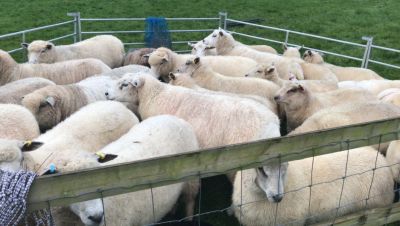
Posted By:
Recently, I have been to several farms to help come up with a plan to reduce lameness in their flocks. Lameness in sheep is a major welfare and economic challenge. It is estimated to cost the industry £24 million, with 3 million sheep lame in the UK at any one time.
There are several reasons why sheep become lame. The most common causes in the UK are Footrot and Scald. To start these investigations, I visited these farms to confirm what the main cause of lameness was in these flocks; to make sure we implement the most appropriate treatment.
On both the farms I visited, I confirmed Footrot as the primary cause of disease. Footrot is an extremely painful disease and affected animals can lose weight rapidly. There is a characteristic foul-smelling discharge. Footrot is caused by the bacterium Dichelobacter nodosus.
On both these farms we used the FAI Five Point Plan, this was developed using existing science on sheep lameness and practical experience from farmers who had achieved and sustained low levels of lameness.
The 5 points can be divided into three areas to Build Resilience, Reduce Disease Challenege and Establish Immunity.
The Five points include:
Cull: Lame ewes spread disease, so an aggressive culling policy is critical in the first year of controlling lameness. Culling repeat offenders.
Avoid: The bacteria that cause footrot are spread from foot to foot via the ground, especially when it is wet and warm. Making sure gate ways are kept as dry as possible, moving mineral buckets and troughs regularly, Applying hyrdrated Lime to high traffic areas will all help to avoid the risk of sheep coming into contact with the bacteria.
Treat: Foot rot will spread quickly though a flock, ensureing rapid treatment of even the mildly lame sheep will help stop the cycle of infection.
Quarantine: Bought in replacement sheep present a risk of introducing different strains of foot rot. New sheep should be kept separate for a minimum of 28 days, any lame sheep should be treated promptly. New sheep can be foot bathed or vaccinated depending on what best suits each farm.
Vaccinate: there is a licensed vaccine available to treat and prevent foot rot
On the farms that I’ve visited, we have only just started to implement these controls. In the New Year, we will assess how they are getting on. Hopefully we will see a significant improvement.
Whilst on my visits I have been having several discussions...
As our feline friends get older there are a few conditions...
Another winter discussion group season is now behind...
©2024 Shepton Veterinary Group Ltd., All rights reserved.
Privacy Policy • Terms & Conditions • Cookie Policy